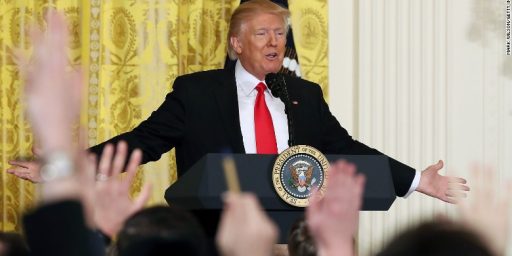On The Twenty-Fifth Amendment
The Twenty-Fifth Amendment has been in the news a lot lately, but what would it actually take to use it to remove a President from power?

In the wake of the publication of Bob Woodward’s book and the anonymous Op-Ed published in The New York Times, there’s been a renewed level of speculation about the application of the 25th Amendment as a means of removing the President from office. Indeed, in Woodward’s book itself, it is alleged that there has been some discussion of that possibility inside the West Wing and former Trump associate Omarosa Manigault Newman has said that there is open talk about the possibility among lower-level staffers as well, with many of them using the rather thinly disguised code word “TFA” to discuss the issue among themselves. While it still seems as though we’re a long way from the point where the provisions of the Amendment can or should be invoked, it seems worthwhile to take a look at exactly what would be involved in that process.
Taken as a whole, the Amendment deals with a number of different topics, only two of which are actually directly related to the issue of Presidential disability. Section One of the Amendment is perhaps the most straightforward in that it merely states that “In case of the removal of the President from office or of his death or resignation, the Vice President shall become President.” While some may have assumed that this was not a necessary part of the Amendment, it’s worth noting that until the Amendment was ratified in 1967 the Constitution was actually silent about what the status of the Vice-President was in the event of the President’s death, impeachment, or resignation. This clause makes it clear that in such an event the Vice-President becomes President in their own right and not merely an “Acting President.” Section Two of the Amendment deals with another situation that had never been addressed by the Constitution, what happens when there is a vacancy in the office of Vice-President, something that happened 15 times from 1789 to 1967, eight times due to the fact that the Vice-President had succeeded to the Presidency and seven times due to the resignation of Richard Nixon and he selected Nelson Rockefeller to serve as Vice-President.
Section Three of the Amendment is the first of the two sections that deal with Presidential disability. In this case it provides the President a means to transmit to the Speaker of the House and President Pro Tempore of the Senate that he will be unable to carry out his duties for some reason, and provides that the Vice-President shall serve as Acting President in such an event. It further provides that the President will resume his duties once he sends a second letter to the same officials advising that he is able to resume the duties of his office. This section has been used in the past to cover situations where the President was undergoing minor surgery or medical testing that required the use of anesthesia. Basically, this section is meant to provide for situations where a President may be temporarily disabled and is able to decide for themselves that the power of the Presidency should be temporarily handed over to the Vice-President, who would act as “Acting President” until the President had recovered. While never formally invoked, the mechanisms of this section were effectively followed several time s over past thirty years due to medical issues faced by Presidents Reagan, Clinton, and George W. Bush.
The section that is relevant to the current situation, though, is Section Four of the Amendment, which essentially provides for a way to involuntarily remove a President who has become disabled, incompetent, or otherwise unable to carry out his or her duties, and it provides as follows:
Section 4. Whenever the Vice President and a majority of either the principal officers of the executive departments or of such other body as Congress may by law provide, transmit to the President pro tempore of the Senate and the Speaker of the House of Representatives their written declaration that the President is unable to discharge the powers and duties of his office, the Vice President shall immediately assume the powers and duties of the office as Acting President.
Thereafter, when the President transmits to the President pro tempore of the Senate and the Speaker of the House of Representatives his written declaration that no inability exists, he shall resume the powers and duties of his office unless the Vice President and a majority of either the principal officers of the executive department or of such other body as Congress may by law provide, transmit within four days to the President pro tempore of the Senate and the Speaker of the House of Representatives their written declaration that the President is unable to discharge the powers and duties of his office. Thereupon Congress shall decide the issue, assembling within forty-eight hours for that purpose if not in session. If the Congress, within twenty-one days after receipt of the latter written declaration, or, if Congress is not in session, within twenty-one days after Congress is required to assemble, determines by two-thirds vote of both Houses that the President is unable to discharge the powers and duties of his office, the Vice President shall continue to discharge the same as Acting President; otherwise, the President shall resume the powers and duties of his office.
To summarize the language above, the process basically works like this:
- First, the Vice-President and a majority of the Cabinet (or some other body that Congress may designate with the task, which has not happened) must send a letter to the Speaker of the House and the President Pro Tempore of the Senate informing them that the President is unable to continue his duties due to a disability. The Amendment does not specify what kind of disability this must be, so that is apparently within the discretion of the Vice-President and Cabinet. At this point, the Vice-President becomes Acting President;
- Second, the President can regain his Presidential powers by sending a letter to the same officials saying that he is either not disabled as alleged or that he is able to resume his duties;
- Third, in response to this, the Vice-President and Cabinet can send another letter to these officials saying that the disability still exists. This letter must be sent within four days after the President has sent his or her letter;
- Fourth, upon receipt of this letter, Congress must convene if it is not already in session and consider the matter. If two-thirds of both chambers of Congress determine by vote that the President is disabled and unable to carry out their duties then the President will be removed from office. Otherwise, the President will resume their duties. If Congress finds by a two-thirds vote that the President is disabled, then the Vice-President becomes Acting President.
This section of the Amendment, obviously, is intended to cover situations where a President becomes so mentally or physically disabled that they are unable to effectively carry out the duties of their office. The classic historical example of this, of course, is President Woodrow Wilson, who suffered a stroke during the final years of his Presidency and was effectively confined to the White House for the remainder of his term, with many openly wondering just how many of the decisions he allegedly made were actually being made by his top staffers and his wife. Something similar nearly happened during the Presidency of Warren Harding when Harding became seriously ill on a trip to the West Coast and lingered several days before he died. Additionally, there was much concern about President Eisenhower’s fitness for office after he had heart attacks during his second term in office. Subsequently revealed history has also indicated that there was at least some discussion of the invocation of this section of the Amendment in the later years of the Reagan Administration when Howard Baker first took over as Chief of Staff and became concerned about the impact of the ongoing Iran/Contra Scandal on the President’s mental state. None of those situations resulted in any action, of course, and so far the discussions about its use have either been academic or confined to dramas involving the White House such as 24 and, more recently, the ABC drama Designated Survivor.
One other thing to keep in mind is that proceeding under the 25th Amendment is, arguably, much more difficult to accomplish than impeachment and removal from office. In order to impeach and remove a President, you need a simple majority of the House and two-thirds of the Senate. To remove a President under Section 4 of the 25th Amendment, you need the agreement of the Vice-President and a majority of the Cabinet, and two-thirds support for removal from both the House of Representatives and the Senate. Given the seriousness of removal under this provision of the Constitution and the obvious intent by the drafters that it only be used in the most extreme circumstances, this is appropriate given the fact that what we’re basically talking about is a Constitutional coup d’etat that is arguably a step beyond impeachment.
Taking all this into account, it is clear that the primary purpose of Section 4 is meant to address situations where a President has become so disabled due to mental or physical disability that they cannot carry out the basic functions of their office. In addition to the classic example of Woodrow Wilson, who historians now believe was largely non-functional during the final years of his time in office, there are many other examples of how this could happen. A President could suffer a stroke or heart attack and be rendered effectively cationic, for example, or an attempted assassination could leave a President severely disabled or in a coma. In those situations, it would be appropriate for a Vice-President and Cabinet to act to ensure that someone can exercise the duties and power of the Presidency until such time as the President recovers, assuming that ever happens. This is especially true in the modern world, where being President means having the authority to protect the nation, command the military, and make the myriad of decisions that, for better or worse, come with the unofficial title “Leader of the Free World.” Thankfully, we’ve never reached the point where that’s been necessary but if it ever is it will be crucial that the parties seeking to invoke this section of the Amendment be able to lay before the American people and before Congress a strong and credible case for doing so. Failure to that would call into question the authority of the Acting President and would imperil the day-to-day functioning of government.
As bad as things have been in the roughly year and a half since Trump has been President, there’s simply no evidence for invoking Section 4 at this time. Trump is not physically unable to carry out his duties, and the arguments that he is suffering from some kind of mental disability or even the early signs of Alzheimer’s Disease, are based largely on speculation by armchair psychologists and others who are basing their opinions largely on what they see on television and comments from so-called experts who ought to know better than to diagnose someone that isn’t a patient of theirs. This isn’t a sufficient basis to take the extraordinary step of attempting to remove a President from office using a provision that has not been tested before under circumstances that would clearly seem to be outside Constitutional norms and not part of the intentions of the drafters of the Amendment.
Rather than disability, the main argument that people pushing the idea of invoking the 25th Amendment against President Trump is that he is a threat to democracy and the Rule of Law not because he has broken laws, although that may have occurred, but because he has violated the norms that we have come to expect from our leaders and which are as crucial to governing the country as adherence to the law and the Constitution, as well as because of the disdain he has shown for the Rule of Law and freedom of the press. If the Constitution is going to be invoked, it should be within the context of those norms, not as a means of getting a President who is clearly in over his head and acting in ways that Presidents should not act. Moreover, while Trump has demonstrated incompetence and a disdain for norms, he has not demonstrated that he is so physically or mentally disabled that he cannot discharge the duties of the Presidential office. Granted, he is discharging those duties badly, and often in support of policies that are not in the interests of the United States, but that isn’t a ground for impeachment or removal from office, and it isn’t a ground for removal under the 25th Amendment.\
Donald Trump has been accused of many things, and the past 604 days have proven pretty much all of the warnings that those of us who have been opposed to him from the beginning to be correct. That doesn’t make him incompetent to carry out his duties, though, and any effort by the Vice-President and the Cabinet to remove him because he is the incompetent, xenophobic, erratic, obnoxious man-child that he always has been would be a mistake. The American people elected him President notwithstanding all of these flaws, and to remove him without something more to support the action than the fact that the first three and a half months of his Presidency would be a mistake that could have serious repercussions for the state of American politics going forward. Donald Trump won the election and he sits in the Oval Office because of that. If he’s going to be removed from office, then it’s Congress’s responsibility to do so using its impeachment power. Failing that, then it is the job of the American people to proceed accordingly at the polls on Election Day.






the past 118 days have proven pretty much all of the warnings that those of us who have been opposed to him from the beginning to be correct.
Two conservative Supreme Court Justices.
Huge tax cuts.
Slashing of federal regulations.
Strong economic growth.
Strong rise in the stock market.
Renegotiated trade deal with Mexico.
Close to renegotiated trade deal with Canada, which could include Canadian concessions considered unthinkable before Trump.
Increasing defense spending by NATO allies.
Continuing the fight against ISIS at least as effectively as past Presidents.
Best position with North Korea since they got nukes and perhaps decades before that.
No stupid wars…yet.
I could go on, of course, but the point isn’t that Trump is doing a good job as President. There’s a perfectly reasonable argument that Trump is NOT doing a good job as President. The point is that Trump is objectively doing a better job than people like Doug Mataconis thought and publicly predicted and doing so in the face of sustained opposition unlike anything any President has faced in decades.
Mike
The 25th amendment won’t be invoked, because despite his innumerable warts, Trump has delivered for the Repugs, the anonymous op-ed is the proof. When the Dems win the House and less likely the Senate, the equation changes and impeachment, not the 25th is the likely tool for removing Trump.
@MBunge:
I just want to run through your list with commentary:
No question — in part because of McConnell’s block of Garland, but yes, this is correct.
Again, yes. It’s the only significant legislation that he has been able to get through Congress (and even then squeaking by… but it happened and will, along with the conservative judiciary be his lasting legacy.
Again yes. Most will be able to be undone by the next left-leaning president. As Obama learned… but still this happened.
Grouping these two together — he has basically continued the trajectory from the Obama administration. And the general rule of thumb is that the first year of any new president is really still his predecessor’s policies. In terms of 2018 (the first real year of Trump’s presidency taking effect), the Stock Market has been largely flat. We have yet to see a real trend here.
Things are doing ok right now. If it continues Trump gets a “win” here, but any actual economist will say it’s too soon to really tell.
Again, you are counting Chickens before they are hatched as (1) this needs Canada’s approval (something that the Mexican President kept saying) and (2) Congress’ approval.
Emphasis on “close”… you are again counting unhatched chickens.
Which they had already agreed to do under Obama. He’s finishing a deal, but again, this isn’t anything new (though he’s claiming responsibility for it).
See below…
Proof? Seriously, PROOF!
At best, we have returned to the Clinton Administration. We do have open lines of communication, but that has more to do with shifts in South Korea than anything else. But until we see actual verification of Nuclear Disarmament (and I know, those pesky experts), we are no closer than Clinton was.
Expanding our support of the awful Saudi War in Yemen (doubling down on one of Obama’s worse FP mistakes) and expanding drone operations in Africa. Not to mention using war as a bargaining strategy with the NORKS. Boots on the ground and a potential escalation in Syria…. Yeah, this is a BS point. We haven’t declared any new wars, but all evidence suggests we’ve increased military operations in multiple theatres.*
BTW, you also seem to skip most of the promises Trump has yet to fulfill… man you are soooo quiet about that existential debt aren’t you?
Without a doubt, Trump’s record is currently mixed. The fall elections and what follows will tell us a lot about his long-term performance.
(note: I intentionally avoided using Woodward and others as a source on a number of your points. If they are to be believed, the reality is that Trump is performing far worse than you suggest. Unless you’re of the mind that staff he picked presenting disasters by going against his wim is a “win”… thought I can see how that could be read that way.)
@MBunge:
To be fair to your position, I think there are plenty of Trump supporters who believe that neither of those things happened under the Obama administration.
That’s of course, demonstratively false. The numbers are clear.
But this has been far more about “feelz” than “factz” for a while.
@MBunge:
Tax cuts themselves are not a success. They were sold with a claim that they would boost the economy so much that they would be paying for themselves.
The economy is growing more slowly than the Obama years, and the deficit will hit $1T.
I don’t think we can count this.
Further, North Korea is a complete cluster fuck at present, with the Norks flagrantly disregarding Trump’s ultimatums while he praises their dictator. Trump believes he has agreements that were never made, and that makes the situation much more likely to lead to war than any time in the past… 40 years?
He scores roughly 2/3 on major hurricanes (Florence still in progress), and has refused to acknowledge problems with the Maria that we could learn from.
And he has divided America more so than any president in the modern era. He’s breaking America as a nation.
And all of the clean water was drained from the swamp, leaving only alligators and muck.
I would refer you to the Republican opposition to the Obamacare administration, including holding a Supreme Court vacancy open for most of a year.
@Gustopher:
Average growth rate of real GDP, Obama years: +1.9%
Average growth rate of real GDP, Obama’s last 6 quarters: +1.5%
Average growth rate of real GDP, Trump’s first 6 quarters: +2.7%
Pretty much, then, Section 4 of the 25th Amendment is, as impeachment, a political process, only harder. That makes it a worse alternative to impeachment.
Still, the Trump problem remains. Removing the chief executive is so hard, that if an incompetent, divisive, actively harmful moron gets elected, there’s no way to deal with him. At least not while the Congress is paralyzed with fear.
I would prefer that Trump be allowed to wither on the vine. Trump will wallow. Trump will harm Republicanism for decades with vain ineptitude.
Pence will actually deliver.
If you want root-and-branch, you need to knee-cap or dis-empower Pence and his crowd.
“Average growth rate of real GDP, Trump’s first 6 quarters: +2.7%”
Financed by increasing the deficit.
Steve
@Leonard: The GDP doesn’t feed your family.
Look at the employment/population ratio — still climbing from the massive drop in 2008, but not as fast as it was during the last two years of the Obama administration, and still nowhere near pre-crash levels (so there’s lots of room to grow)
@Gustopher: “The economy is growing more slowly than the Obama years, and the deficit will hit $1T.” False.
@MBunge:
Yes, benefiting Corporations and the very wealthy. Also resulting in the largest projected deficits in a time of non-economic crisis.
Source: https://www.wsj.com/articles/deficit-projected-to-top-1-trillion-starting-next-year-1531950742
Analogy: If you decide not to pay the bills, and take advances out on a credit card, you may SEEM to have a LOT of money. But that only lasts for a short time.
The question is: What happens when the line of credit dries up and bills need to get paid?
Answer: You elect a Democrat.
@Leonard:
I guess that 1 Trillion figure is not False, eh? — So much for conservative deficit hawks. — I suppose they will wait for a Democrat president so they can start to push for the elimination of Social Security and Medicare again. (After Corporations get 100% deductions against earnings on new corporate jets in this administration, of course).